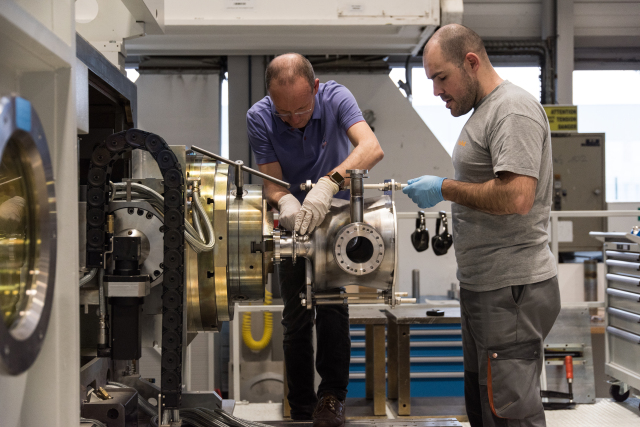Yet another success in the creating of a bright future for the Large Hadron Collider (LHC) was achieved when, on 27 February 2017, the first tests of a new kind of radio-frequency (RF) cavity – crab cavities – were performed. They are one of the key elements for the High-Luminosity LHC (HL-LHC) project – the future upgrade of the LHC, which will be operational from 2025.
Constructed from high-purity niobium sheets, the crab cavities will operate at 2 Kelvin to reach their nominal performance. Unlike the accelerating RF cavities at LHC Point 4, the crab cavities give the bunches a time-dependent transverse kick in a plane that is perpendicular to their motion. The present configuration of the LHC interaction regions, and that of the future HL-HLC, features an intrinsic crossing angle with which the beams collide. By placing the crab cavities near the interaction regions of ATLAS and CMS, the bunches are rotated around their barycentres in order to maximise their overlap at the collision points.

So far, two superconducting crab cavities have been manufactured at CERN. RF tests at their operating temperature of 2 K were performed in a super-fluid helium bath in the SM18 test facility. The first cavity tests demonstrated a maximum voltage reach in excess of 5 MV transverse kick voltage, surpassing the nominal operational voltage of 3.4 MV. This kick voltage corresponds to extremely high electric and magnetic fields on the cavity surfaces: 57 MV/m and 104 mT respectively.
By the end of 2017, the two crab cavities will have been inserted into a specially designed cryomodule. During the next year-end technical stop, the cryomodule will be installed in the Super Proton Synchrotron (SPS), where it will undergo validation tests with proton beams. This will be the first time that a crab cavity has ever been used for manipulating proton beams. In total, 16 crab cavities will be installed in the High-Luminosity LHC – eight near ATLAS and eight near CMS.
“With the tests in the SPS, we want to make sure that the proton beams can be injected and accelerated and establish stable circulating proton beams with the crab cavities in operation. We want to manipulate the parameters of the crab cavities like we would in the LHC,” explains Rama Calaga, the RF physicist behind the technology and currently leader of the crab cavity work package within the HL-LHC project.

